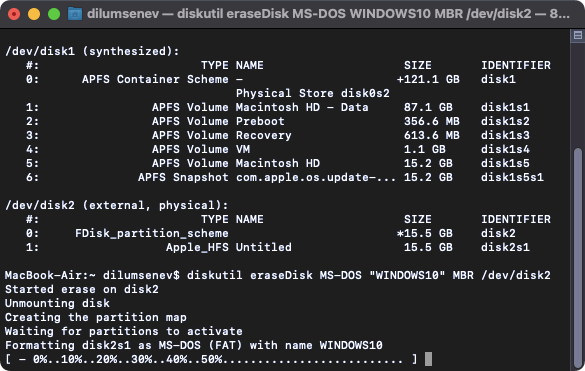
- #HOW TO ACCESS MEMORY STICK FROM MACBOOK COMMAND PROMPT HOW TO#
- #HOW TO ACCESS MEMORY STICK FROM MACBOOK COMMAND PROMPT INSTALL#
- #HOW TO ACCESS MEMORY STICK FROM MACBOOK COMMAND PROMPT FULL#
- #HOW TO ACCESS MEMORY STICK FROM MACBOOK COMMAND PROMPT ANDROID#
- #HOW TO ACCESS MEMORY STICK FROM MACBOOK COMMAND PROMPT SOFTWARE#
In the case of an SD Card, do not select the memory card as the destination as you might end up overwriting the very files you just recovered.You have to specify the destination for saving the recovered files and click on “OK.”.Suppose you have a computer with multiple accounts you can trace back a recovered photo to the rightful owner. In case you are interested in only recovering photos, click on “Pictures” from the left pane.ĭisk Drill also allows file search based on the user. You can utilize the filters available in the toolbar for narrowing down search results. Now, you can select the files you wish to retrieve and click on the “Recover” button. Once Disk Drill completes scanning, all recoverable files are displayed on the screen.

On the other hand, a deep scan is an extensive and comprehensive procedure that can dig up files deleted some time ago. A quick scan is ideal if you deleted the file quite recently. If you click on the drop-down “All recovery methods,” you can specify the type of scan: Quick or Deep scan.
#HOW TO ACCESS MEMORY STICK FROM MACBOOK COMMAND PROMPT FULL#
Drag and drop the Disk Drill application into this Full Disk Access list.On the left pane, click on Full Disk Access.In the Privacy tab, click on the Lock Icon (marked in screenshot).To do so, head over to System Preferences and select “Security & Privacy:”.This step is critical as Apple imposes certain restrictions. Before initiating any photo recovery process, you must grant Disk Drill full unrestricted disk access.
#HOW TO ACCESS MEMORY STICK FROM MACBOOK COMMAND PROMPT INSTALL#
If you intend to recover files from an internal hard drive, install Disk Drive on an external hard drive.
#HOW TO ACCESS MEMORY STICK FROM MACBOOK COMMAND PROMPT SOFTWARE#
If you want to recover deleted photos from your Mac, do not install any photo recovery software on the affected device. Go to the destination folder and check if you can open the recovered photos. Click on “OK.” The “partially recovered” segment represents damaged files that weren’t fully recovered. Now, Recuva transfers all the recovered files to the destination location. Determine the location for saving the retrieving files from the File Location dialog box. In some cases, yellow circles pop up – signifying a partially recoverable file: which in the case of photos could manifest as jarred lines spewed across or colors missing. A green circle represents a fully recoverable file, while a red circle tells you that the file isn’t recoverable. The colored circle beside the file name indicates the recoverability status. Now, check the files you wish to retrieve and click on the “Recover” button. Click on “scan” to initiate the scan sequence, and the tool pulls up a list of “recoverable” pictures. For instance, if you want to recover all the C: Drive folders, use this feature. Check the “restore folder structure” if you plan on recovering large files. If a regular scan doesn’t yield any “recoverable” photos, check the “Deep Scan” feature and scan again. Click on Options and go to the “Actions” tab that reveals a bunch of options. Select the drive (from the drop-down) on which you want Recuva to scan and retrieve photos – SD Card in this case.

Answer the questions that pop up on the Rescue Wizard: Read more to check out the nitty-gritty of some popular tools across a few operating systems. Fortunately, there are pretty reliable tools out there. If you do find any, you just struck gold! If not, we got you covered!ĭata recovery tools are your only shot if the recycle bin and backups are empty. Search through your cloud-hosted accounts for any possible backups. You never know! Your Google Photos or iCloud account might have an auto backup instance turned on.
#HOW TO ACCESS MEMORY STICK FROM MACBOOK COMMAND PROMPT ANDROID#
Additionally, some Android phones have a native “recycle” feature as well. The Mac and Windows PCs have the Trash can and Recycle Bin, respectively. Here are some pretty straightforward tips that we don’t consider to be full-fledged “data recovery techniques.” Still, it’s worth giving them a shot: 🗑️ Check the Recycle BinĪn absolute no-brainer, right? Nevertheless, many people push the panic button before giving the Recycle Bin a glance.
#HOW TO ACCESS MEMORY STICK FROM MACBOOK COMMAND PROMPT HOW TO#


 0 kommentar(er)
0 kommentar(er)
